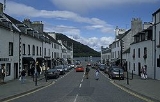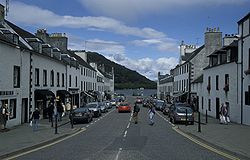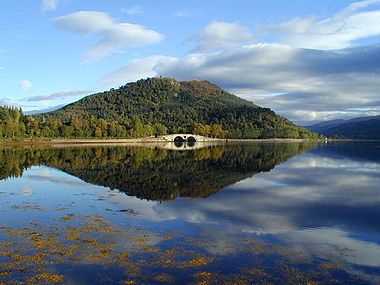
Inveraray
Encyclopedia
Inveraray is a royal burgh
in Argyll and Bute
, Scotland
. It is on the western shore of Loch Fyne
, near its head, and on the A83 road
. It is the traditional county town of Argyll
and ancestral home to the Duke of Argyll
.
s.
Arthur Charles Fox-Davies
, in his 1909 book A Complete Guide to Heraldry, notes the following:
. Over the years the castle has played host to numerous luminaries; Queen Victoria visited it in 1847, and the Royal connection was further cemented when her daughter, Princess Louise, married the heir to the Campbell chieftainship, the Marquis of Lorne, in 1875, illustrating the elevated position of the Argyll family in the social pecking order of the times. The town prior to the reconstruction of the castle was little more than a collection of humble cottages adjacent to the castle site and the Duke wished that the populace be moved to improve the appearance of his home.


.jpg)
 As early as 1747 William Adam had drawn up plans for the creation of a new Inveraray. By 1770, however, little had been done, and it was the fifth Duke who set about rebuilding the town in its present form. Much of the work on the rebuilt Inveraray was done by John Adam, the Argyll Hotel on Front Street being his, as well as the Town House. Most of the new Inveraray, however, was the creation of Robert Mylne, a celebrated architect of the period. The end product was an attractive town which included houses for estate workers, a woollen mill, and a pier to exploit herring fishing, which was to mushroom in later years to play a major role in the town's economy.
As early as 1747 William Adam had drawn up plans for the creation of a new Inveraray. By 1770, however, little had been done, and it was the fifth Duke who set about rebuilding the town in its present form. Much of the work on the rebuilt Inveraray was done by John Adam, the Argyll Hotel on Front Street being his, as well as the Town House. Most of the new Inveraray, however, was the creation of Robert Mylne, a celebrated architect of the period. The end product was an attractive town which included houses for estate workers, a woollen mill, and a pier to exploit herring fishing, which was to mushroom in later years to play a major role in the town's economy.
The finished product is one of the best examples of an 18th century new town in Scotland, and the vast majority of the properties in the centre of Inveraray are considered worthy of protection because of the town's architectural significance. The celebrated essayist Doctor Johnson, himself no fan of Scotland, was moved to comment on the new Inveraray: 'What I admire here is the total defiance of expense".
Much of the town, including the church, was designed and built by the Edinburgh-born architect Robert Mylne
(1733-1811) between 1772 and 1800.
Inveraray Jail
in the burgh is now a museum
. Other attractions include the Argyll Folk Museum at Auchindrain. The Celtic
Inveraray Cross can also been seen in the town. The Inverarary Maritime Heritage Museum is based on the iron sailing ship Arctic Penguin, moored at the pier
, along with the Clyde puffer
s VIC 72, Eilean Eisdeal, renamed Vital Spark
, and VIC27 Auld Reekie, renamed Maggie. The Bell Tower dominates the town, and contains the second-heaviest ring of ten bells in the world. The bell tower is open to the public, and the bells are rung regularly.
Since Scottish Government regulation passed in 2004 mandating bus drivers to take a break every two hours, the town has become a major coach stop, as it is almost exactly two hours away from Glasgow. All services connecting Campbeltown, Oban and Fort William to or from Glasgow stop at Inveraray, for around 20 minutes.
is a popular local sport, Inveraray Shinty Club
being crowned Scottish Champions
in 2004. Inveraray and District Pipe band was formed in 2005 after a 70 years gap. In their first competing year, 2006, they won a trophy at every competition. They are now the Grade 2 world champions.
The well is above the town reached from up the Dalmally road.
Royal burgh
A royal burgh was a type of Scottish burgh which had been founded by, or subsequently granted, a royal charter. Although abolished in 1975, the term is still used in many of the former burghs....
in Argyll and Bute
Argyll and Bute
Argyll and Bute is both one of 32 unitary council areas; and a Lieutenancy area in Scotland. The administrative centre for the council area is located in Lochgilphead.Argyll and Bute covers the second largest administrative area of any Scottish council...
, Scotland
Scotland
Scotland is a country that is part of the United Kingdom. Occupying the northern third of the island of Great Britain, it shares a border with England to the south and is bounded by the North Sea to the east, the Atlantic Ocean to the north and west, and the North Channel and Irish Sea to the...
. It is on the western shore of Loch Fyne
Loch Fyne
Loch Fyne is a sea loch on the west coast of Argyll and Bute, Scotland. It extends inland from the Sound of Bute, making it the longest of the sea lochs...
, near its head, and on the A83 road
A83 road
The A83 is a major road in Argyll and Bute, Scotland, running from Tarbet, on the western shore of Loch Lomond, where it splits from the A82, to Campbeltown at the southern end of the Kintyre peninsula.-Route:...
. It is the traditional county town of Argyll
Argyll
Argyll , archaically Argyle , is a region of western Scotland corresponding with most of the part of ancient Dál Riata that was located on the island of Great Britain, and in a historical context can be used to mean the entire western coast between the Mull of Kintyre and Cape Wrath...
and ancestral home to the Duke of Argyll
Duke of Argyll
Duke of Argyll is a title, created in the Peerage of Scotland in 1701 and in the Peerage of the United Kingdom in 1892. The Earls, Marquesses, and Dukes of Argyll were for several centuries among the most powerful, if not the most powerful, noble family in Scotland...
.
Coat of arms
The town's coat of arms depicts a net cast out over the ocean, entangled in which are five herringHerring
Herring is an oily fish of the genus Clupea, found in the shallow, temperate waters of the North Pacific and the North Atlantic oceans, including the Baltic Sea. Three species of Clupea are recognized. The main taxa, the Atlantic herring and the Pacific herring may each be divided into subspecies...
s.
Arthur Charles Fox-Davies
Arthur Charles Fox-Davies
Arthur Charles Fox-Davies was a British author on heraldry. By profession, he was a barrister but he also worked as a journalist and novelist.Born in Bristol, he was the second son of T...
, in his 1909 book A Complete Guide to Heraldry, notes the following:
There is no doubt of its ancient usage. ...and the blazon of the coat, according to the form it is depicted upon the Corporate seal, would be for the field: "The sea proper, therein a net suspended from the dexter chief and the sinister fess points to the base; and entangled in its meshes five herrings," which is about the most remarkable coat of arms I have ever come across.
Inveraray Castle
In 1744 the third Duke of Argyll decided to demolish the existing castle and start from scratch with a new building. The castle was 40 years in construction, and the work was largely supervised by the Adam family, still renowned to this day as gifted architects and designers. The end product was not a castle in the traditional sense, but a classic Georgian mansion house on a grand scale, Inveraray CastleInveraray Castle
Inveraray Castle is an estate house near Inveraray in Argyll in western Scotland.It is the seat of the Duke of Argyll and a Category A listed building.-Ghosts:...
. Over the years the castle has played host to numerous luminaries; Queen Victoria visited it in 1847, and the Royal connection was further cemented when her daughter, Princess Louise, married the heir to the Campbell chieftainship, the Marquis of Lorne, in 1875, illustrating the elevated position of the Argyll family in the social pecking order of the times. The town prior to the reconstruction of the castle was little more than a collection of humble cottages adjacent to the castle site and the Duke wished that the populace be moved to improve the appearance of his home.
Rebuilding the town


.jpg)

The finished product is one of the best examples of an 18th century new town in Scotland, and the vast majority of the properties in the centre of Inveraray are considered worthy of protection because of the town's architectural significance. The celebrated essayist Doctor Johnson, himself no fan of Scotland, was moved to comment on the new Inveraray: 'What I admire here is the total defiance of expense".
Much of the town, including the church, was designed and built by the Edinburgh-born architect Robert Mylne
Robert Mylne
Robert Mylne was a Scottish architect and civil engineer, particularly remembered for his design for Blackfriars Bridge in London. Born and raised in Edinburgh, he travelled to Europe as a young man, studying architecture in Rome under Piranesi...
(1733-1811) between 1772 and 1800.
Tourist attractions
Its distinctive white buildings on the loch shore make it photogenic and it is a popular tourist destination, with a number of attractions in addition to the castle. The GeorgianGeorgian architecture
Georgian architecture is the name given in most English-speaking countries to the set of architectural styles current between 1720 and 1840. It is eponymous for the first four British monarchs of the House of Hanover—George I of Great Britain, George II of Great Britain, George III of the United...
Inveraray Jail
Inveraray Jail
The Inveraray Gaol in Inveraray, Argyll and Bute, Scotland is known as a living 19th-century prison.-History:Designed by James Gillespie Graham in 1813 after original plans by Robert Reid in 1807. The original plans had called for a courthouse and three prisons, one for males, one for females and...
in the burgh is now a museum
Museum
A museum is an institution that cares for a collection of artifacts and other objects of scientific, artistic, cultural, or historical importance and makes them available for public viewing through exhibits that may be permanent or temporary. Most large museums are located in major cities...
. Other attractions include the Argyll Folk Museum at Auchindrain. The Celtic
Celtic cross
A Celtic cross is a symbol that combines a cross with a ring surrounding the intersection. In the Celtic Christian world it was combined with the Christian cross and this design was often used for high crosses – a free-standing cross made of stone and often richly decorated...
Inveraray Cross can also been seen in the town. The Inverarary Maritime Heritage Museum is based on the iron sailing ship Arctic Penguin, moored at the pier
Pier
A pier is a raised structure, including bridge and building supports and walkways, over water, typically supported by widely spread piles or pillars...
, along with the Clyde puffer
Clyde puffer
The Clyde puffer is essentially a type of small steamboat which provided a vital supply link around the west coast and Hebrides islands of Scotland, stumpy little cargo ships that have achieved almost mythical status thanks largely to the short stories Neil Munro wrote about the Vital Spark and her...
s VIC 72, Eilean Eisdeal, renamed Vital Spark
Vital Spark
The Vital Spark is a fictional Clyde puffer, created by Scottish writer Neil Munro. As its captain, the redoubtable Para Handy, often says: "the smertest boat in the coastin' tred"....
, and VIC27 Auld Reekie, renamed Maggie. The Bell Tower dominates the town, and contains the second-heaviest ring of ten bells in the world. The bell tower is open to the public, and the bells are rung regularly.
Since Scottish Government regulation passed in 2004 mandating bus drivers to take a break every two hours, the town has become a major coach stop, as it is almost exactly two hours away from Glasgow. All services connecting Campbeltown, Oban and Fort William to or from Glasgow stop at Inveraray, for around 20 minutes.
Sport
ShintyShinty
Shinty is a team game played with sticks and a ball. Shinty is now played mainly in the Scottish Highlands, and amongst Highland migrants to the big cities of Scotland, but it was formerly more widespread, being once competitively played on a widespread basis in England and other areas in the...
is a popular local sport, Inveraray Shinty Club
Inveraray Shinty Club
Inveraray Shinty Club is a shinty club from Inveraray, Argyll, Scotland. It plays in the Scottish Hydro Premier Division. There is also a reserve team who plays in the South Division One as well as a Ladies team.-History:...
being crowned Scottish Champions
Camanachd Cup
The Camanachd Association Challenge Cup AKA the Camanachd Cup or Scottish Cup is the premier prize in the sport of shinty...
in 2004. Inveraray and District Pipe band was formed in 2005 after a 70 years gap. In their first competing year, 2006, they won a trophy at every competition. They are now the Grade 2 world champions.
The Wishing Well
The Wishing Well - The place mentioned is Bealach an Fhuarain, pronounced Bealachanuaran. Designed by William Adam in 1747. Inside a perennial spring flows into a rock basin. The overflow is carried off in a shallow, winding channel. In the 1770s the water was conveyed by wooden pipes to a cistern to supply the new town of Inveraray, then building. When the Bell Tower foundation was being excavated in 1923 a 10 foot length of the old water pipe was unearthed. Known by people as the wishing well. This info is from Donald McKechnie's Inveraray notes.The well is above the town reached from up the Dalmally road.

